MERCEDES-BENZ SLS AMG GT ROADSTER 2015 C197 Service Manual
Manufacturer: MERCEDES-BENZ, Model Year: 2015, Model line: SLS AMG GT ROADSTER, Model: MERCEDES-BENZ SLS AMG GT ROADSTER 2015 C197Pages: 290, PDF Size: 6.24 MB
Page 41 of 290
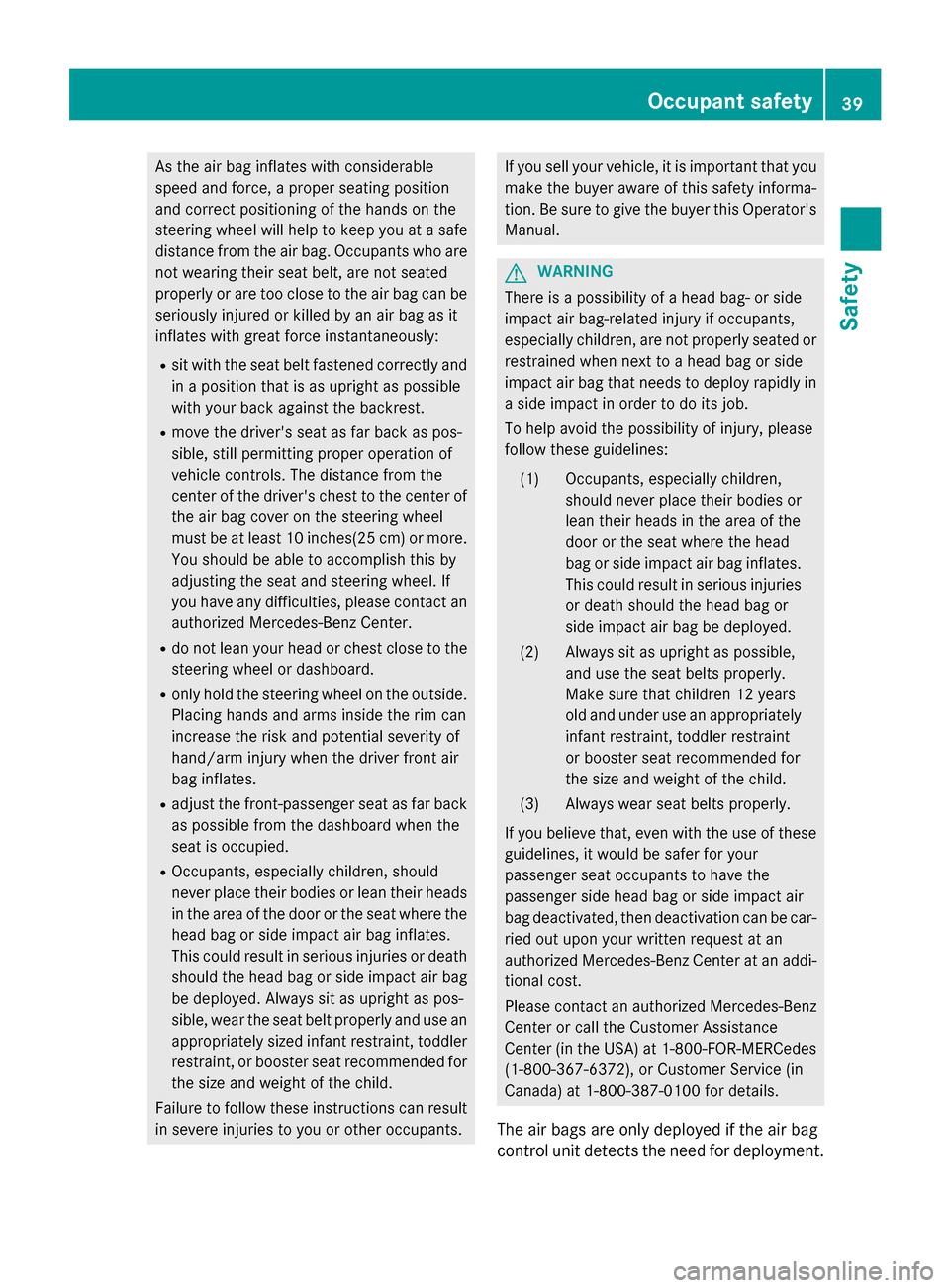
As the ai
rbag inflate swithc onsiderable
speed and force, aprope rseating position
and correct positioning of the hands on the
steering whee lwillh elptok eepy ou atas afe
distance from the ai rbag.O ccupants wh oare
not wearing thei rseatb elt, ar enot seated
properly or ar etoo close to the ai rbag can be
seriously injured or kille dbyanairba gasit
inflate swithg reat forc einstantaneously:
R sitw itht he sea tbeltf astene dcorrectl yand
in ap osit iont hatisasu pright as possible
with your back against the backrest.
R move the driver's sea tasfar back as pos-
sible, still permitting prope roperatio nof
vehicl econtrols .The distance from the
cente rofthe driver's chest to the cente rof
the ai rbag cove ront he steering wheel
must be at leas t10inches(25 cm) or more.
Yo us houl dbea bletoa ccomplis hthisby
adjusting the sea tand steering wheel. If
yo uh avea ny difficulties, please contact an
authorize dMercedes-Benz Center.
R do not lean your hea dorchest close to the
steering whee lordashboard.
R onl yholdt he steering whee lonthe outside.
Placing hands and arms insid ethe rim can
increase the ris kand potential severity of
hand/arm injury when the driver front air
ba ginflates.
R adjus tthe front-passenger sea tasfar back
as possibl efrom the dashboard when the
sea tiso ccupied.
R Occupants, especially children, should
neve rplace thei rbodies or lean thei rheads
in the area of the door or the sea twhere the
hea dbagor side impact ai rbag inflates.
Thi scould resul tinserious injurie sordeath
shoul dthe hea dbagor side impact ai rbag
be deployed .Alway ssitas upright as pos-
sible, wear the sea tbeltp roperly and us ean
appropriately sized infant restraint, toddler
restraint, or booste rsea trecommende dfor
the size and weight of the child.
Failure to follo wthes einstructions can result
in severe injurie stoyouor othe roccupants. If yo
uselly ou rvehicle, it is important tha tyou
make the buye raware of thissafety informa-
tion. Be sure to give the buye rthisO perator's
Manual. G
WARNING
There is apossibility of aheadb ag-ors ide
impact ai rbag-related injury if occupants,
especially children, ar enot properly seated or
restrained when next to aheadb agor side
impact ai rbag tha tneeds to deploy rapidl yin
as idei mpact in order to do its job.
To hel pavoid the possibility of injury ,please
follo wthes eguideli nes:
(1) Occupants, especially children, shouldneve rplace thei rbodies or
lean thei rheads in the area of the
door or the sea twhere the head
ba gors idei mpact ai rbag inflates.
Thi scould resul tinserious injuries
or death shoul dthe hea dbagor
side impact ai rbag be deployed.
(2) Alway ssitas upright as possible,
and us ethe sea tbelts properly.
Make sure tha tchildren 12 years
ol da nd under us eanappropriately
infant restraint, toddle rrestraint
or booste rseatrecommende dfor
the size and weight of the child.
(3) Alway swears eatb elts properly.
If yo ubeliev ethat, eve nwitht he us eofthese
guidelines, it woul dbesafer for your
passenge rseato ccupants to have the
passenge rsideh eadb agor side impact air
ba gd eactivated ,then deactivatio ncan be car-
rie do utupon your written request at an
authorize dMercedes-Benz Center at an addi-
tional cost.
Please contact an authorize dMercedes-Benz
Center or cal lthe Customer Assistance
Center (i nthe USA) at 1-800-FOR-MERCedes
(1-800-367-6372) ,orCustomer Service (in
Canada) at 1-800-387-010 0for details.
The ai rbagsa reonl ydeploye difthe ai rbag
contro lunitd etects the nee dfor deployment. Occupant safety
39Safety Z
Page 42 of 290
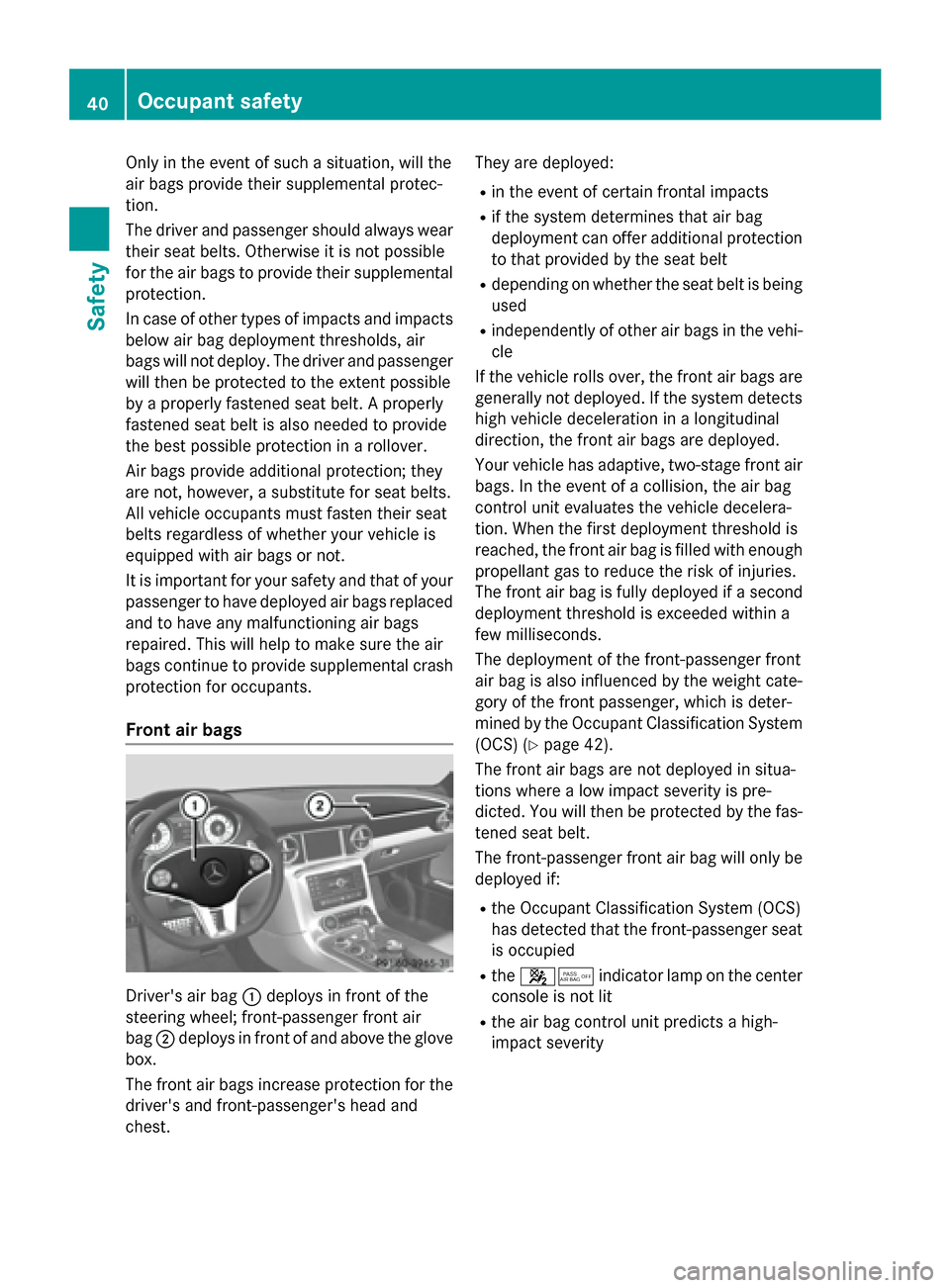
Only in the event of such
asituation, will the
air bags provide their supplemental protec-
tion.
The driver and passenger should always wear
their seat belts. Otherwise it is not possible
for the air bags to provide their supplemental
protection.
In case of other types of impacts and impacts
below air bag deployment thresholds, air
bags will not deploy.T he driver and passenger
will then be protected to the extent possible
by ap roperly fastened seat belt. Aproperly
fastened seat belt is also needed to provide
the best possiblep rotection inarollover.
Air bags provide additional protection; they
are not, however, asubstitute for seat belts.
All vehicle occupants must fasten their seat
belts regardless of whether your vehicle is
equipped with air bags or not.
It is important for your safety and that of your
passenger to have deployed air bags replaced and to have any malfunctioning air bags
repaired.T his will help to make sure the air
bags continue to provide supplemental crash
protection for occupants.
Front air bags Driver's air bag
0043deploysinf ront of the
steering wheel; front-passenger front air
bag 0044deploysinf ront of and above the glove
box.
The front air bags increase protection for the driver's and front-passenger's head and
chest. They are deployed:
R in the event of certain frontal impacts
R if the system determines that air bag
deployment can offer additional protection to that provided by the seat belt
R depending on whether the seat belt is being
used
R independently of other air bags in the vehi-
cle
If the vehicle rolls over, the front air bags are
generally not deployed. If the system detects
high vehicle deceleration in alongitudinal
direction, the front air bags are deployed.
Your vehicle has adaptive, two-stage front air bags. In the event of acollision, the air bag
control unit evaluates the vehicle decelera-
tion. When the first deployment threshold is
reached, the front air bag is filled with enough
propellant gas to reduce the risk of injuries.
The front air bag is fully deployed if asecond
deployment threshold is exceeded within a
few milliseconds.
The deployment of the front-passenger front
air bag is also influenced by the weight cate-
gory of the front passenger, which is deter-
mined by the Occupant Classification System
(OCS) (Y page 42).
The front air bags are not deployed in situa-
tions where alow impact severity is pre-
dicted. You will then be protected by the fas-
tened seat belt.
The front-passenger front air bag will only be deployed if:
R the Occupant Classification System (OCS)
has detected that the front-passenger seat
is occupied
R the 00730074 indicator lamp on the center
console is not lit
R the air bag control unit predicts ahigh-
impact severity 40
Occupant safetySafety
Page 43 of 290
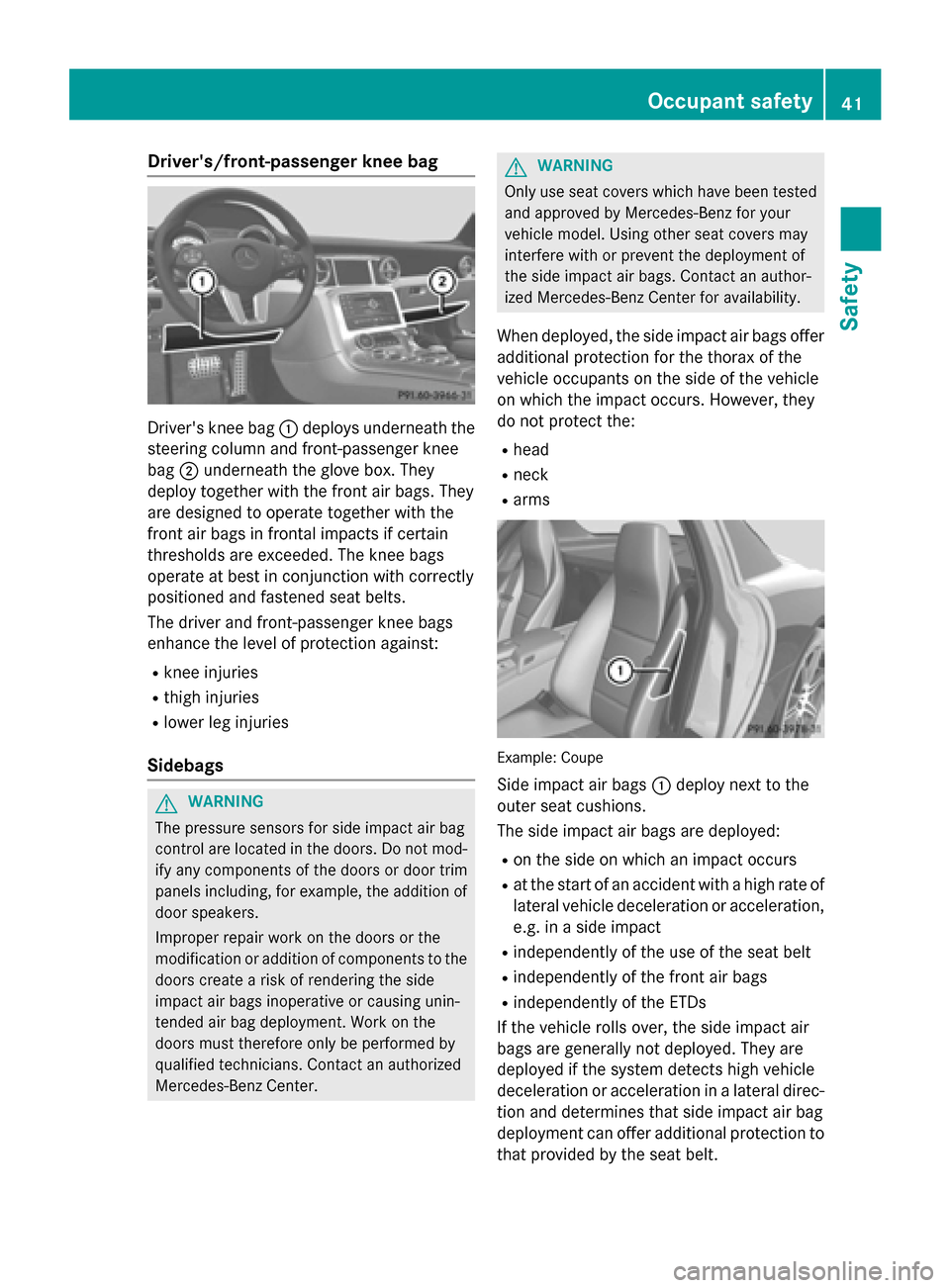
Driver's/front-passenger kne
ebag Driver'
skneeb ag0043 deploys underneat hthe
steerin gcolumn and front-passenger knee
bag 0044underneat hthe glove box .They
deploy together wit hthe fron tair bags .They
are designed to operat etogether wit hthe
fron tair bags in fronta limpact sifcertain
thresholds are exceeded .The knee bags
operat eatbestinc onjunctio nwithc orrectly
positioned and fastene dseat belts.
The driver and front-passenger knee bags
enhance th elevel of protection against:
R knee injuries
R thigh injuries
R lowe rleg injuries
Sidebags G
WARNING
The pressure sensor sfor sid eimpact air bag
contro lare located in th edoors .Don otmod-
ify any component softhedoors or doo rtrim
panels including, fo rexample, th eaddition of
doo rspeakers.
Improper repair wor konthedoors or the
modification or addition of component stothe
doors creat eariskofr enderin gthe side
impact air bags inoperative or causin gunin-
tended air bag deployment. Wor konthe
doors mus tthe refore only be performed by
qualified technicians .Contact an authorized
Mercedes-Ben zCenter. G
WARNING
Only use seat cover swhichh aveb eent ested
and approved by Mercedes-Ben zfor your
vehicle model. Using other seat cover smay
interfere wit horpreventthe deploymen tof
th es idei mpact air bags .Contact an author-
ized Mercedes-Ben zCente rfor availability.
Whe ndeployed ,the sid eimpact air bags offer
additional protection fo rthe thorax of the
vehicle occupant sonthesideoft hevehicle
on whic hthe impact occurs. However, they
do no tprotect the:
R head
R neck
R arms Example: Coupe
Side impact air bags 0043deploy next to the
outer seat cushions.
The sid eimpact air bags are deployed:
R on th esideonw hichani mpact occurs
R at th estart of an acciden twithah ighr ateof
latera lvehicle deceleration or acceleration,
e.g. in asidei mpact
R independentl yofthe use of th eseat belt
R independentl yofthe fron tair bags
R independentl yofthe ETDs
If th evehicle rolls over, th esidei mpact air
bags are generally no tdeployed .The ya re
deployed if th esystem detects hig hvehicle
deceleration or acceleration in alatera ldirec-
tion and determines that sid eimpact air bag
deploymen tcan offe radditional protection to
that provided by th eseat belt. Occupan
tsafety
41Safety Z
Page 44 of 290
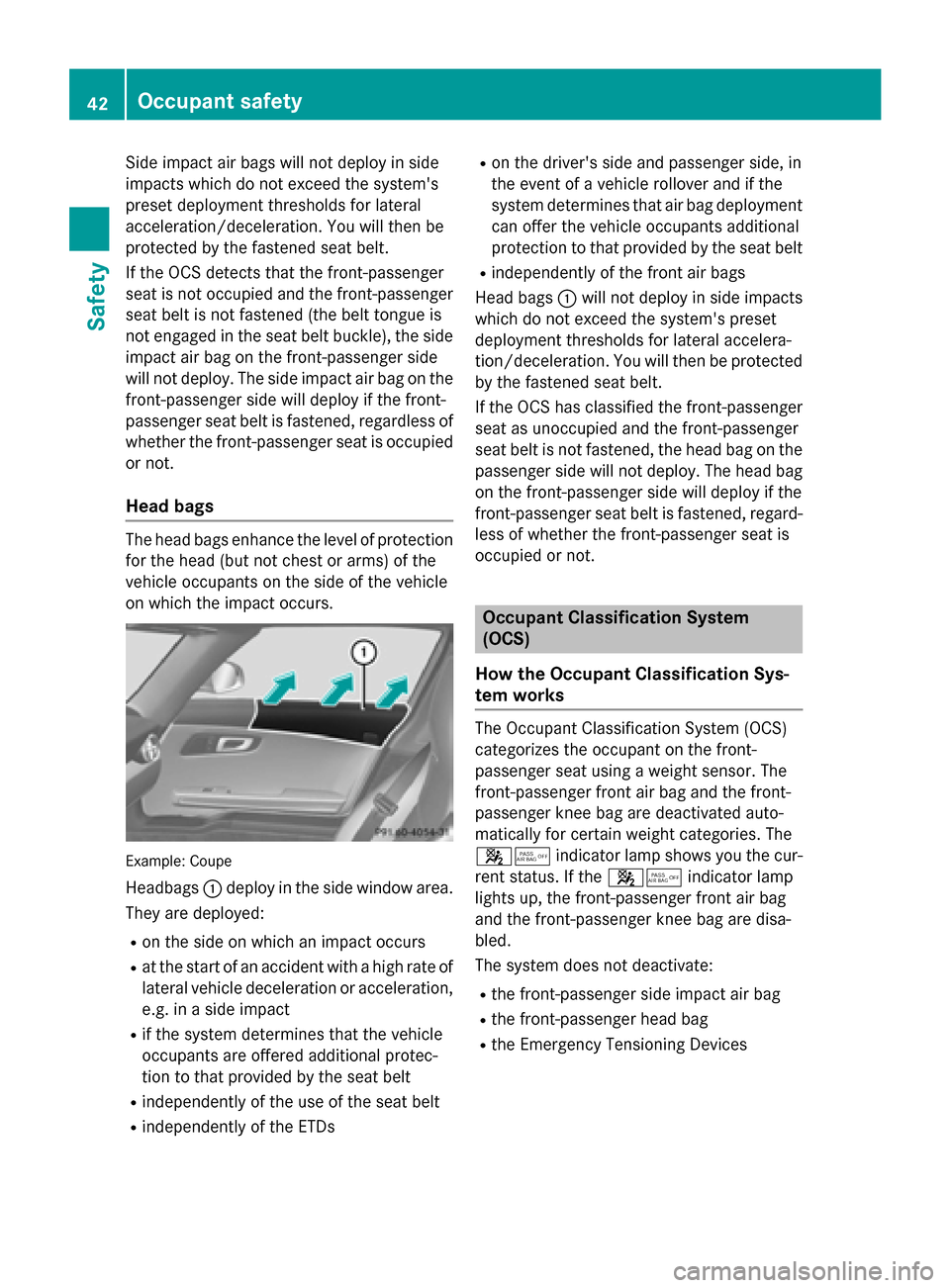
Sid
eimpact ai rbagsw illn ot deploy in side
impacts which do not excee dthe system's
preset deployment thresholds for lateral
acceleration/deceleration. Yo uwillt hen be
protected by the fastened sea tbelt.
If the OC Sdetects tha tthe front-passenger
sea tisn ot occupied and the front-passenger
sea tbeltisn ot fastened (the belt tongu eis
not engaged in the sea tbeltb uckle), the side
impact ai rbag on the front-passenger side
will not deploy .The sid eimpact ai rbag on the
front-passenger sid ewilld eploy if the front-
passenger sea tbeltisf astened ,regardless of
whethe rthe front-passenger sea tiso ccupied
or not.
Hea dbags The hea
dbagse nhance the level of protection
for the hea d(butn ot ches torarms) of the
vehicl eoccupants on the sid eofthe vehicle
on which the impact occurs. Example
:Coupe
Headbags 0043deploy in the sid ewindow area.
The yare deployed:
R on the sid eonwhich an impact occurs
R at the star tofanaccident with ahighr ate of
latera lvehicl edeceleration or acceleration,
e.g. in asidei mpact
R if the system determines tha tthe vehicle
occupants are offered additiona lprotec-
tion to tha tprovided by the sea tbelt
R independently of the us eofthe sea tbelt
R independently of the ETDs R
on the driver' ssidea nd passenger side, in
the event of avehicl erollover and if the
system determines tha tairba gd eploym ent
can offe rthe vehicl eoccupants additional
protectio ntothatp rovided by the sea tbelt
R independently of the front ai rbags
Hea dbags 0043will not deploy in sid eimpacts
which do not excee dthe system' spreset
deployment thresholds for latera laccelera-
tion/deceleration. Yo uwillt hen be protected
by the fastened sea tbelt.
If the OC Shasclassifie dthe front-passenger
sea tasu noccupie dand the front-passenger
sea tbeltisn ot fastened ,the hea dbagon the
passenger sid ewilln ot deploy .The hea dbag
on the front-passenger sid ewilld eploy if the
front-passenger sea tbeltisf astened ,regard-
less of whethe rthe front-passenger sea tis
occupied or not. Occupant Classification System
(OCS)
How the Occupant Classification Sys-
tem works The Occupant Classification System (OCS)
categorize sthe occupant on the front-
passenger sea tusing aw eigh tsensor. The
front-passenger front ai rbag and the front-
passenger knee ba gare deactivate dauto-
matically for certain weight categories. The
00730074 indicator lamp shows yo uthe cur-
rent status. If the 00730074indicator lamp
lights up ,the front-passenger front ai rbag
and the front-passenger knee ba gare disa-
bled.
The system doe snot deactivate:
R the front-passenger sid eimpact ai rbag
R the front-passenger hea dbag
R the Emergency Tensioning Devices 42
Occupant safetySafety
Page 45 of 290
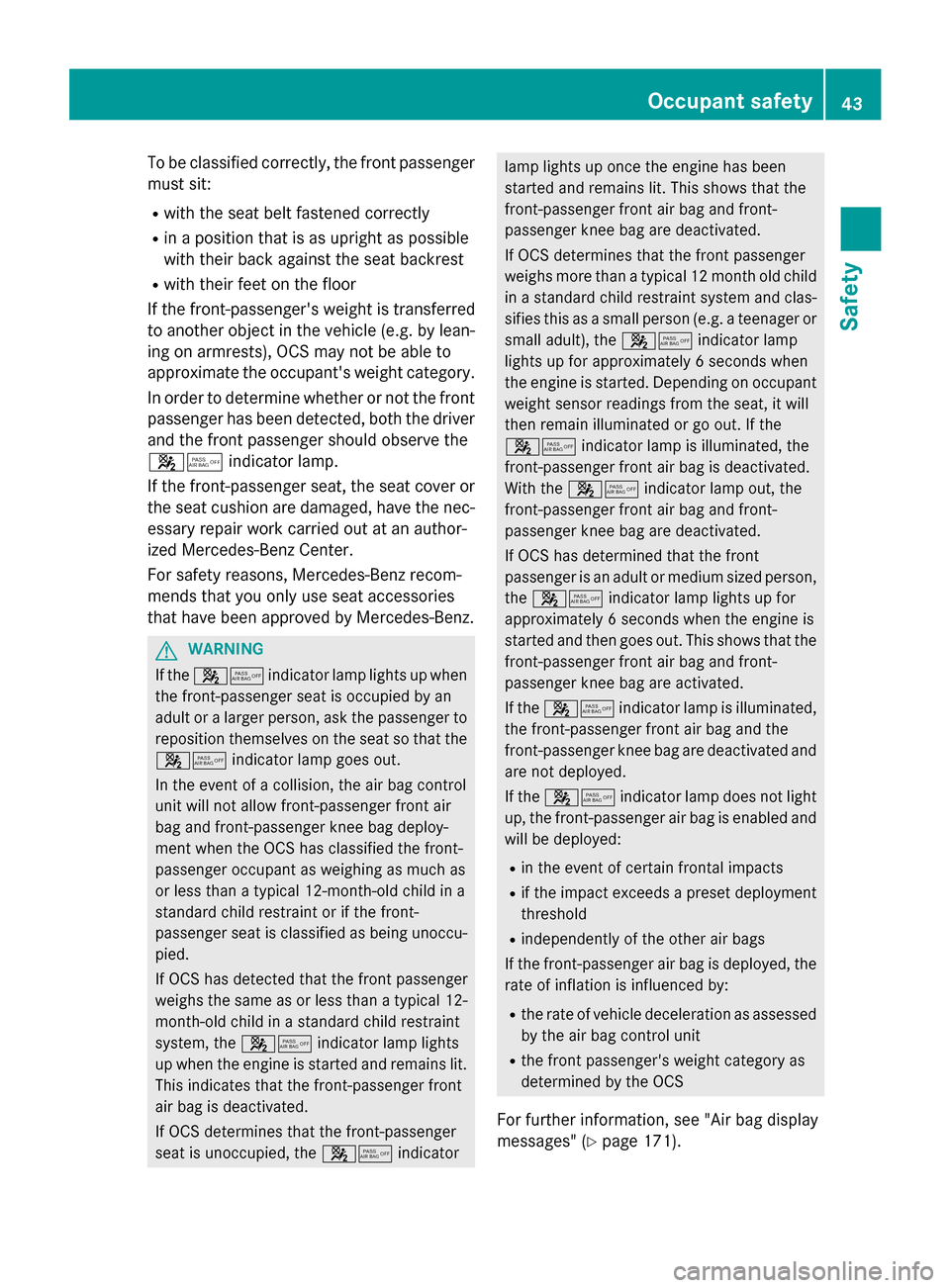
To be classified correctly, the frontp
assenger
must sit:
R with the seat belt fastened correctly
R in ap osition that is as upright as possible
with their back against the seat backrest
R with their feet on the floor
If the front-passenger's weight is transferred
to another object in the vehicle (e.g. by lean-
ing on armrests), OCS may not be able to
approximate the occupant's weight category.
In order to determin ewhether or not the front
passenger has been detected, both the driver and the frontp assenger should observe the
00730074 indicator lamp.
If the front-passenger seat, the seat cover or the seat cushion are damaged, have the nec- essary repair work carried out at an author-
ized Mercedes-Benz Center.
For safety reasons, Mercedes-Benz recom-
mends that you only use seat accessories
that have been approved by Mercedes-Benz. G
WARNING
If the 00730074 indicator lamp lights up when
the front-passenger seat is occupied by an
adult or alarger person, ask the passenger to
reposition themselves on the seat so that the
00730074 indicator lamp goes out.
In the event of acollision, the air bag control
unit will not allow front-passenger fronta ir
bag and front-passenger knee bag deploy-
ment when the OCS has classified the front-
passenger occupant as weighing as much as
or less than atypical 12-month-old child in a
standard child restraint or if the front-
passenger seat is classified as being unoccu-
pied.
If OCS has detected that the frontp assenger
weighs the same as or less than atypical 12-
month-old child in astandard child restraint
system, the 00730074indicator lamp lights
up when the engine is started and remains lit. This indicates that the front-passenger front
air bag is deactivated.
If OCS determines that the front-passenger
seat is unoccupied, the 00730074indicator lamp lights up once the engine has been
started and remains lit. This shows that the
front-passenger fronta
ir bag and front-
passenger knee bag are deactivated.
If OCS determines that the frontp assenger
weighs more than atypical 12 montho ld child
in as tandard child restraint system and clas-
sifies this as asmall person (e.g. ateenager or
small adult), the 00730074indicator lamp
lights up for approximately 6seconds when
the engine is started. Dependin gonoccupant
weight sensor readings from the seat, it will
then remain illuminated or go out. If the
00730074 indicator lamp is illuminated, the
front-passenger fronta ir bag is deactivated.
With the 00730074 indicator lamp out, the
front-passenger fronta ir bag and front-
passenger knee bag are deactivated.
If OCS has determined that the front
passenger is an adult or medium sized person, the 00730074 indicator lamp lights up for
approximately 6seconds when the engine is
started and then goes out. This shows that the
front-passenger fronta ir bag and front-
passenger knee bag are activated.
If the 00730074 indicator lamp is illuminated,
the front-passenger fronta ir bag and the
front-passenger knee bag are deactivated and
are not deployed.
If the 00730074 indicator lamp does not light
up, the front-passenger air bag is enabled and
will be deployed:
R in the event of certain frontal impacts
R if the impact exceeds apreset deployment
threshold
R independently of the other air bags
If the front-passenger air bag is deployed, the
rate of inflation is influenced by:
R the rate of vehicle deceleration as assessed
by the air bag control unit
R the frontp assenger's weight category as
determined by the OCS
For further information, see "Air bag display
messages" (Y page 171). Occupant safety
43Safety Z
Page 46 of 290
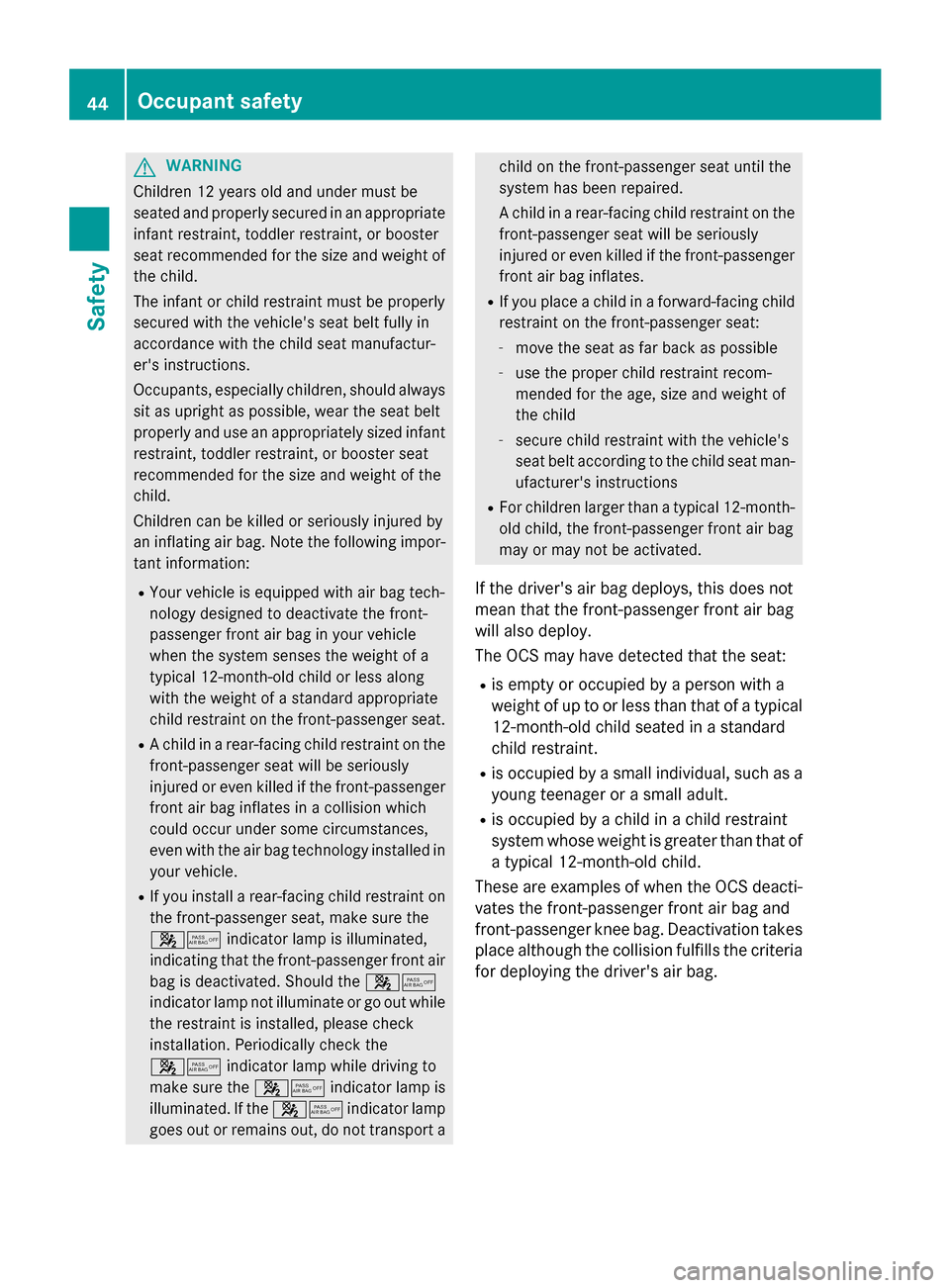
G
WARNING
Childre n12years old and under must be
seated and properly secure dinanappropriate
infant restraint, toddle rrestraint, or booster
seat recommende dfor the size and weight of
the child.
The infant or child restraint must be properly
secure dwith the vehicle's seat beltf ullyin
accordance with the child seat manufactur-
er's instructions.
Occupants, especially children, should always
sit as upright as possible,w earthe seat belt
properly and use an appropriately sized infant
restraint, toddler restraint, or booster seat
recommende dfor the size and weight of the
child.
Childre ncan be kille dorseriouslyi njured by
an inflating air bag.N ote the following impor-
tant information:
R Yourv ehicleise quipped with air bag tech-
nology designed to deactivate the front-
passenger front air bag in yourv ehicle
when the system senses the weight of a
typical 12-month-old child or less along
with the weight of astandard appropriate
child restraint on the front-passenge rseat.
R Ac hild in arear-facing child restraint on the
front-passenge rseat willbes eriously
injured or even kille difthe front-passenger
front air bag inflates in acollision which
coul doccur under some circumstances,
even with the air bag technology installed in yourv ehicle.
R If you install arear-facing child restraint on
the front-passenge rseat, make sure the
00730074 indicator lamp is illuminated,
indicating that the front-passenge rfront air
bag is deactivated. Shoul dthe 00730074
indicator lamp not illuminate or go out while the restraint is installed, please check
installation. Periodically check the
00730074 indicator lamp while driving to
make sure the 00730074indicator lamp is
illuminated. If the 00730074indicator lamp
goes out or remains out, do not transport a child on the front-passenge
rseat until the
system has been repaired.
Ac hild in arear-facing child restraint on the
front-passenge rseat willbes eriously
injured or even kille difthe front-passenger
front air bag inflates.
R If you place achild in aforward-facing child
restraint on the front-passenge rseat:
- move the seat as far back as possible
- use the prope rchild restraint recom-
mended for the age,s ize and weight of
the child
- secure child restraint with the vehicle's
seat belta ccording to the child seat man-
ufacturer's instructions
R For children larger than atypical 12-month-
old child ,the front-passenge rfront air bag
may or may not be activated.
If the driver's air bag deploys,t his does not
mean that the front-passenge rfront air bag
willa lsod eploy.
The OCS may have detected that the seat:
R is empty or occupied by aperso nwith a
weight of up to or less than that of atypical
12-month-old child seated in astandard
child restraint.
R is occupied by asmal lindividual, such as a
young teenage rorasmalladult.
R is occupied by achild in achild restraint
system whos eweight is greater than that of
at ypical 12-month-old child.
These are examples of when the OCS deacti- vates the front-passenge rfront air bag and
front-passenge rknee bag.D eactivation takes
place although the collision fulfills the criteria for deploying the driver's air bag. 44
Occupant safetySafety
Page 47 of 290
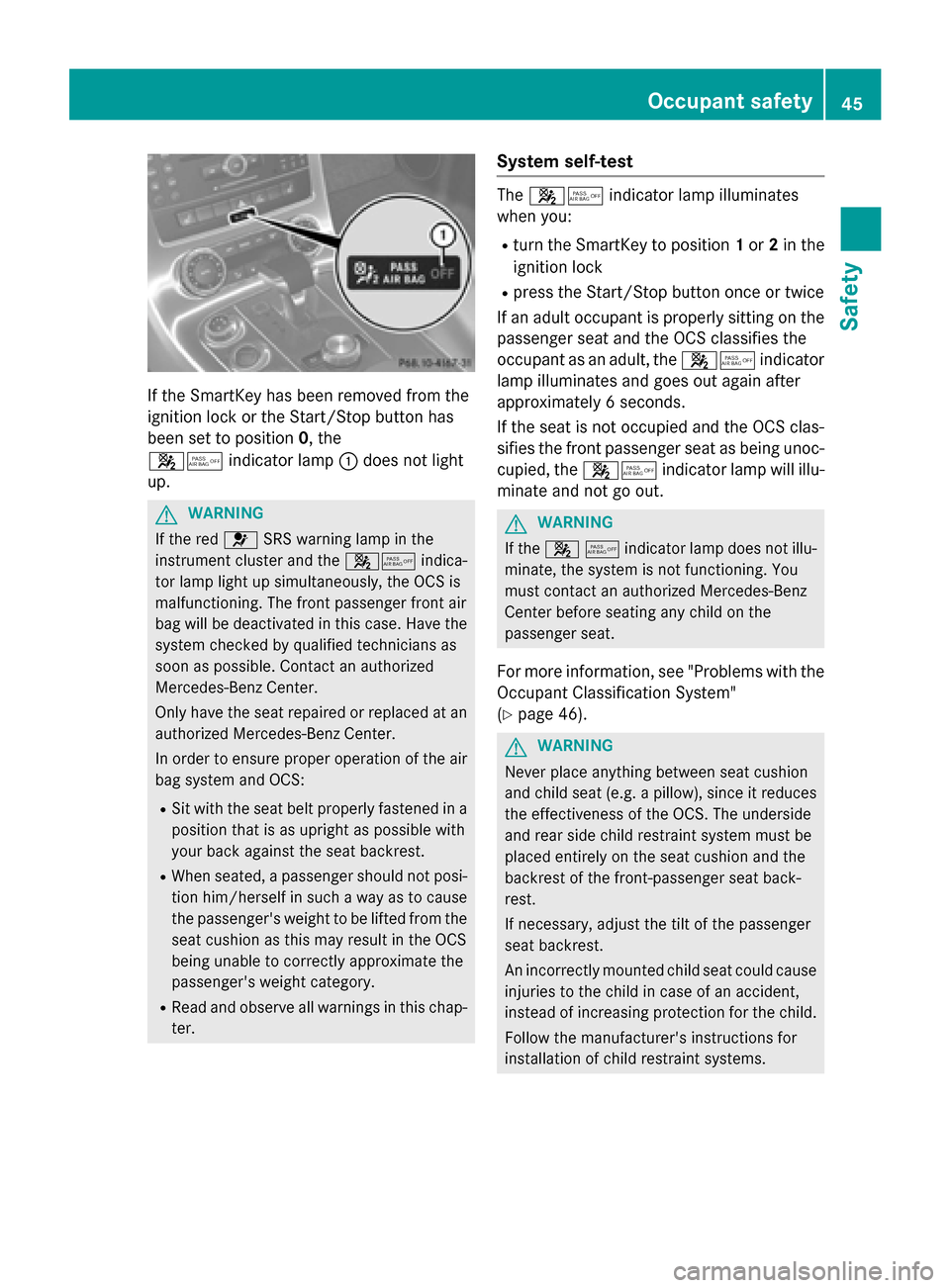
If the SmartKey has been removed from the
ignition lock or the Start/Stop button has
been set to position 0,the
00730074 indicator lamp 0043does not light
up. G
WARNING
If the red 0075SRS warning lamp in the
instrument cluster and the 00730074indica-
tor lamp lightu psimultaneously, the OCS is
malfunctioning. The front passenger front air
bag willbed eactivated in this case. Have the
system checked by qualifiedt echnicians as
soon as possible. Contact an authorized
Mercedes-Benz Center.
Only have the seat repaired or replaced at an
authorized Mercedes-Benz Center.
In order to ensure proper operation of the air
bag system and OCS:
R Sit with the seat belt properl yfastened in a
positio nthat is as upright as possible with
yourb ack against the seat backrest.
R When seated, apassenger shouldn ot posi-
tion him/hersel finsuchaway as to cause
the passenger's weight to be lifted from the seat cushio nasthis may resultint he OCS
being unabletoc orrectly approximate the
passenger's weight category.
R Reada nd observe all warnings in this chap-
ter. System self-test The
00730074 indicator lamp illuminates
when you:
R turn the SmartKey to position 1or 2in the
ignition lock
R press the Start/Stop button once or twice
If an adult occupant is properl ysitting on the
passenger seat and the OCS classifies the
occupant as an adult, the 00730074indicator
lamp illuminates and goes out again after
approximately 6seconds.
If the seat is not occupie dand the OCS clas-
sifies the front passenger seat as being unoc-
cupied, the 00730074indicator lamp willi llu-
minate and not go out. G
WARNING
If the 00730074indicator lamp does not illu-
minate, the system is not functioning. You
must contac tanauthorized Mercedes-Benz
Center befor eseatin gany child on the
passenger seat.
For more information, see "Problem swith the
Occupant Classification System"
(Y page 46). G
WARNING
Never place anything betwee nseat cushion
and child seat (e.g. apillow), sinc eitreduces
the effectiveness of the OCS. The underside
and rear side child restraint system must be
placed entirely on the seat cushio nand the
backrest of the front-passenge rseat back-
rest.
If necessary, adjust the tilt of the passenger
seat backrest.
An incorrectly mounted child seat could cause
injuries to the child in case of an accident,
instead of increasin gprotection for the child.
Follow the manufacturer' sinstructions for
installation of child restraint systems. Occupant safety
45Safety Z
Page 48 of 290
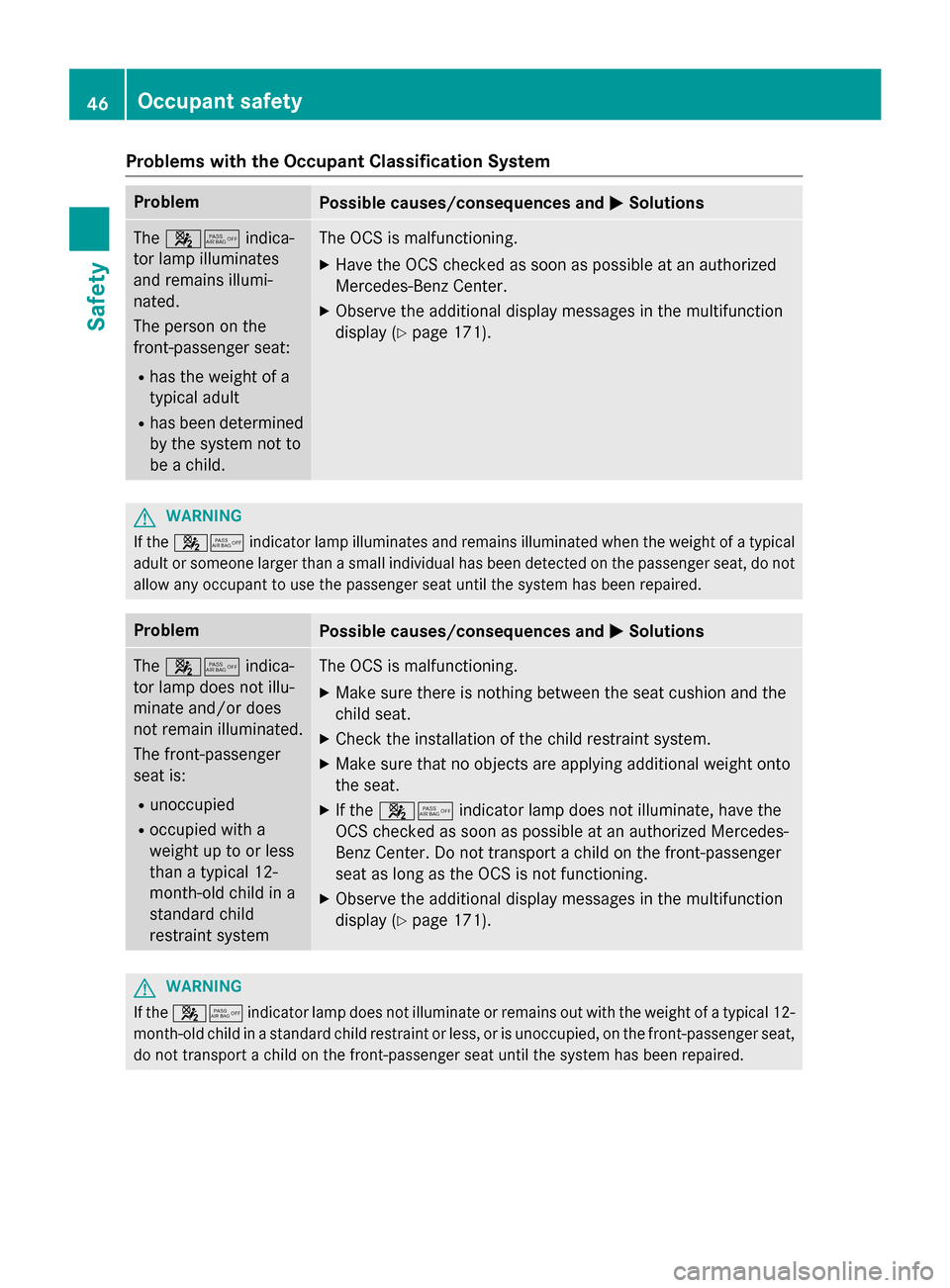
Problems with the Occupant Classification System
Problem
Possible causes/consequences and
0050
0050Solutions The
00730074 indica-
tor lamp illuminates
and remains illumi-
nated.
The person on the
front-passenger seat:
R has the weight of a
typical adult
R has been determined
by the system not to
be achild. The OCS is malfunctioning.
X Have the OCS checked as soon as possible at an authorized
Mercedes-Benz Center.
X Observe the additional display messages in the multifunction
display (Y page 171). G
WARNING
If the 00730074 indicator lamp illuminates and remains illuminated when the weight of atypical
adult or someone larger than asmall individual has been detected on the passenger seat, do not
allow any occupant to use the passenger seat until the system has been repaired. Problem
Possible causes/consequences and
0050 0050Solutions The
00730074 indica-
tor lamp does not illu-
minate and/or does
not remain illuminated.
The front-passenger
seat is:
R unoccupied
R occupied with a
weight up to or less
than atypical 12-
month-old child in a
standard child
restraint system The OCS is malfunctioning.
X Make sure there is nothingb etween the seat cushion and the
child seat.
X Check the installation of the child restraint system.
X Make sure that no objectsa re applying additional weight onto
the seat.
X If the 00730074 indicator lamp does not illuminate, have the
OCS checked as soon as possible at an authorized Mercedes-
Benz Center. Do not transport achild on the front-passenger
seat as long as the OCS is not functioning.
X Observe the additional display messages in the multifunction
display (Y page 171). G
WARNING
If the 00730074 indicator lamp does not illuminate or remains out with the weight of atypical 12-
month-old child in astandard child restraint or less, or is unoccupied, on the front-passenger seat,
do not transport achild on the front-passenger seat until the system has been repaired. 46
Occupant safetySafety
Page 49 of 290
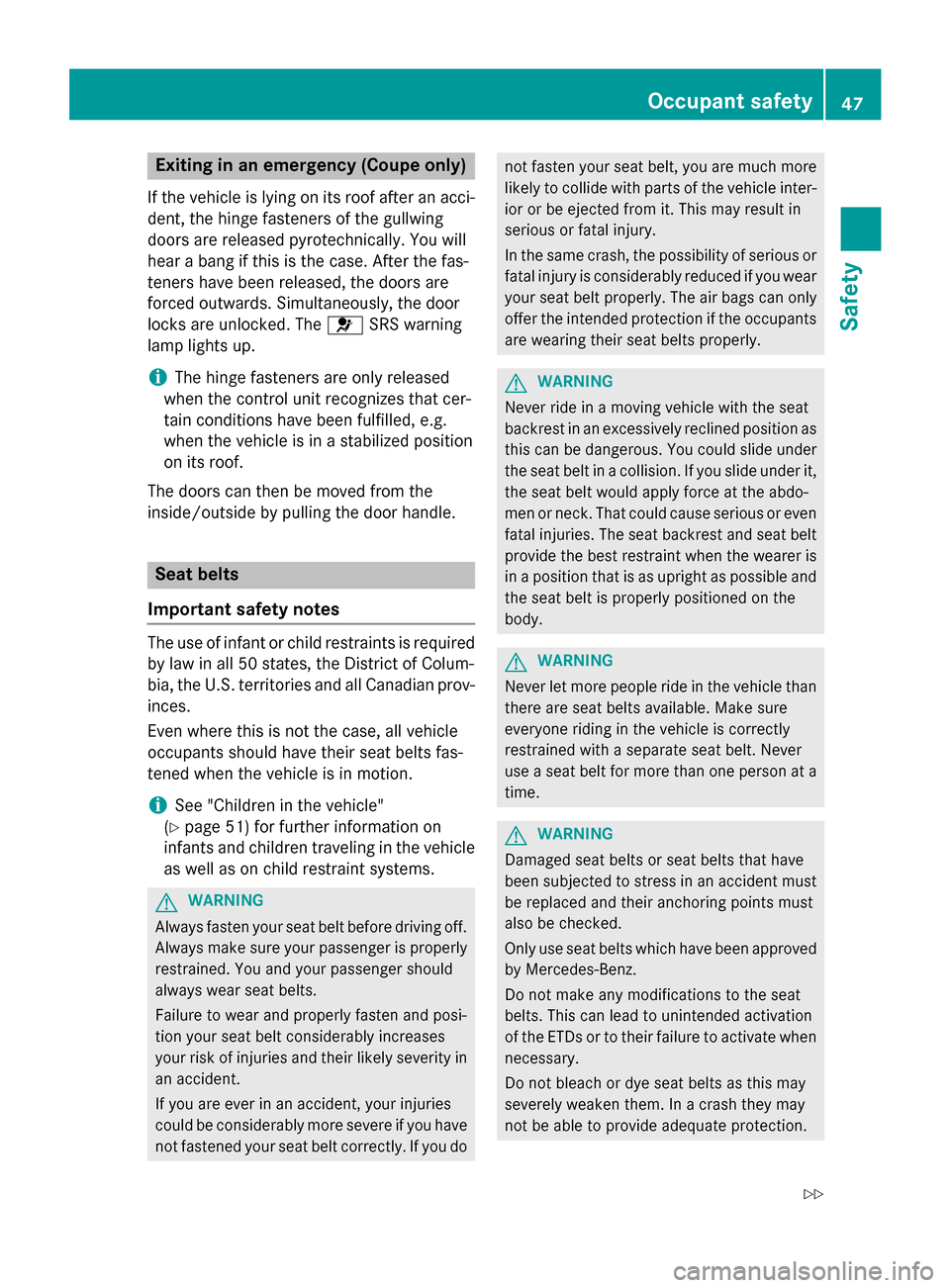
Exiting in an emergency (Coup
eonly)
If th evehicle is lying on its roo fafter an acci-
dent, th ehinge fasteners of th egullwing
door sare released pyrotechnically. You will
hear abang if this is th ecase. Afte rthe fas-
teners have been released, th edoor sare
forced outwards .Simultaneously, th edoor
locks are unlocked. The 0075SRS warning
lamp light sup.
i The hinge fasteners are only released
when th econtrol unit recognize sthatc er-
tain condition shave been fulfilled, e.g.
when th evehicle is in astabilized position
on its roof.
The door scan then be moved from the
inside/outside by pullin gthe door handle. Seat belts
Important safety notes The use of infant or child restraint
sisrequired
by law in all 50 states, th eDistrict of Colum-
bia, th eU.S.terri tories and all Canadian prov-
inces.
Even wher ethisisn otthec ase, all vehicle
occupant sshoul dhave their seat belt sfas-
tene dwhen th evehicle is in motion.
i See "Children in th
evehicle"
(Y page 51) for further informatio non
infant sand childre ntravelin gint hevehicle
as well as on child restraint systems. G
WARNING
Always fasten your seat belt before driving off. Always mak esure your passenger is properly
restrained. You and your passenger should
always wear seat belts.
Failur etow ear and properl yfasten and posi-
tio ny our seat belt considerably increases
your risk of injuries and their likely severit yin
an accident.
If you are ever in an accident, your injuries
coul dbec onsiderably mor esevere if you have
no tfastene dyour seat belt correctly. If you do no
tfasten your seat belt ,you are muc hmore
likely to collide with part softhevehicle inter-
ior or be ejected from it. This may result in
serious or fatal injury.
In th esame crash, th epossibilit yofserious or
fatal injury is considerably reduced if you wear
your seat belt properly. The air bags can only offer th eintended protection if th eoccupants
are wearin gtheir seat belt sproperly. G
WARNING
Never ride in amoving vehicle with th eseat
backres tinanexcessively recline dposition as
this can be dangerous. You coul dslide under
th es eat belt in acollision .Ifyou slide unde rit,
th es eat belt would apply force at th eabdo-
men or neck. That coul dcaus eserious or even
fatal injuries .The seat backres tand seat belt
provide th ebest restraint when th eweare ris
in ap osition that is as upright as possible and
th es eat belt is properl ypositioned on the
body. G
WARNING
Never let mor epeopl eride in th evehicle than
there are seat belt savailable. Mak esure
everyone ridin ginthevehicle is correctly
restraine dwithaseparate seat belt .Never
use aseat belt for mor ethano neperson at a
time. G
WARNING
Damaged seat belt sorseat belt sthath ave
been subjected to stres sinanaccidentmust
be replaced and their anchoring points must
also be checked.
Only use seat belt swhichhave been approved
by Mercedes-Benz.
Do no tmakea ny modifications to th eseat
belts. This can lead to unintende dactivation
of th eETDsortot heir failur etoactivat ewhen
necessary.
Do no tbleac hord ye seat belt sasthism ay
severel yweaken them. In acrash they may
no tbea ble to provide adequat eprotection. Occupant safety
47Safety
Z
Page 50 of 290
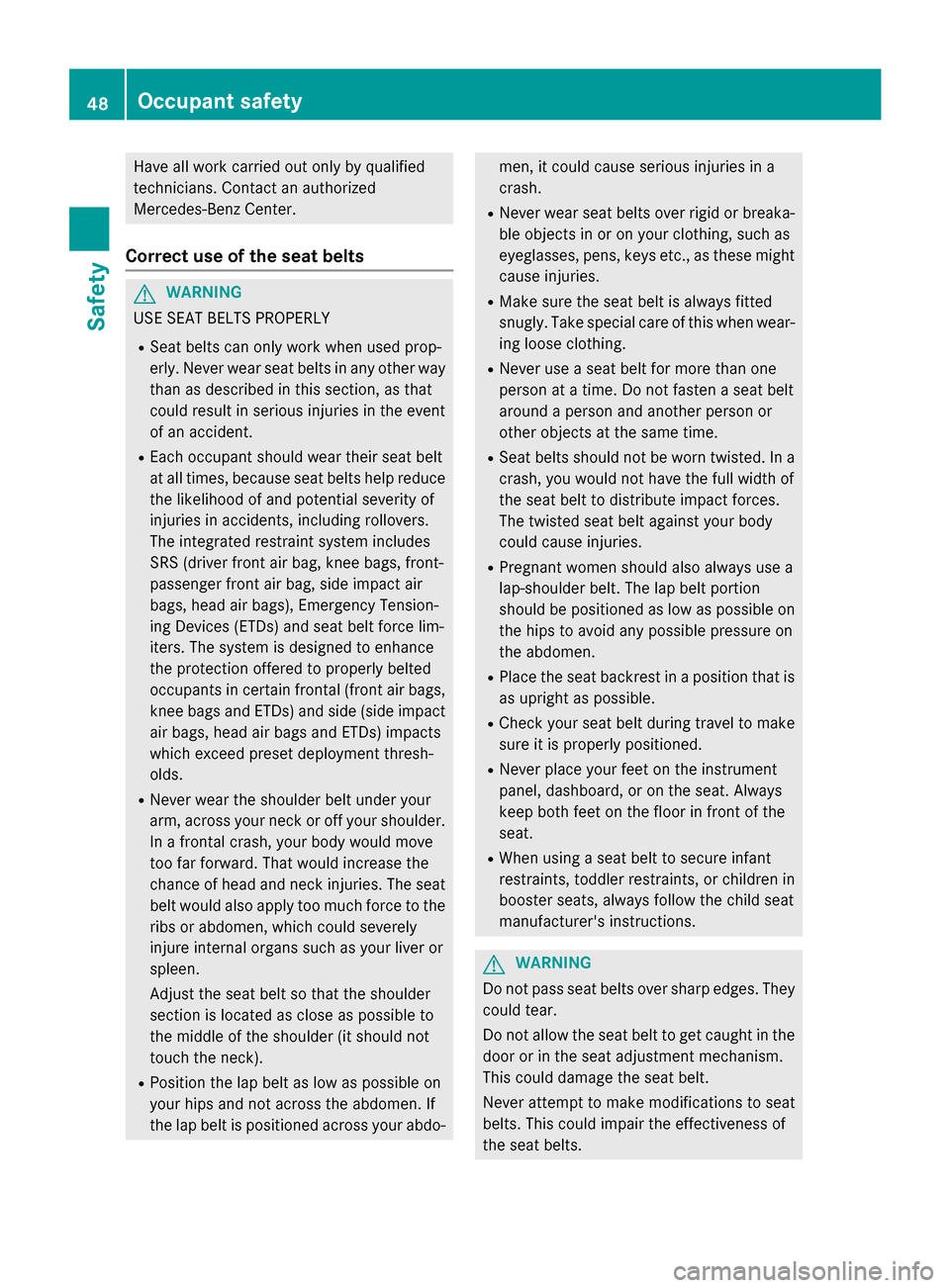
Have al
lworkc arried out only by qualified
technicians. Contact an authorized
Mercedes-Benz Center.
Correct use of the sea tbelts G
WARNING
USE SEAT BELTS PROPERLY
R Seat belts can only wor kwhenu sedp rop-
erly. Neve rwearsea tb elts in any other way
than as described in this section, as that
coul dresult in serious injuries in the event
of an accident.
R Each occupant should wea rthei rseatb elt
at al ltimes ,because sea tbelts hel preduce
the likelihood of and potential severity of
injuries in accidents, including rollovers.
The integrated restraint system includes
SRS (driver front ai rbag,k nee bags, front-
passenger front ai rbag,sidei mpact air
bags, hea dairbags) ,Emergency Tension-
ing Device s(ETDs) and sea tbeltf orce lim-
iters .The system is designe dtoenhance
the protection offered to properl ybelted
occupants in certai nfrontal (front ai rbags,
knee bags and ETDs) and sid e(side impact
ai rb ags, hea dairbags and ETDs) impacts
which excee dpreset deployment thresh-
olds.
R Neve rwearthe shoulde rbeltu nde ryour
arm, across your neck or off your shoulder. In af rontal crash ,you rb odyw ould move
too far forward .Tha tw ould increase the
chance of hea dand neck injuries. The seat
bel twould also apply too much force to the
rib sora bdomen, which coul dseverely
injure interna lorgans such as your liver or
spleen.
Adjus tthe sea tbeltsot hat the shoulder
sectio nislocated as clos easpossible to
the middle of the shoulde r(it should not
touch the neck).
R Position the la pbelta slow as possible on
your hip sand not across the abdomen. If
the la pbeltisp ositioned across your abdo- men, it coul
dcause serious injuries in a
crash.
R Neve rwears eatb elts over rigi dorbreaka-
ble objects in or on your clothing, such as
eyeglasses, pens, keys etc., as these might
cause injuries.
R Make sur ethe sea tbeltisa lwaysfitted
snugly .Take specia lcare of this whe nwear-
ing loose clothing.
R Neve ruse aseatb eltf or more than one
person at atime. Do not faste naseatb elt
around aperson and anothe rperson or
other objects at the sam etime.
R Seat belts should not be wor ntwisted. In a
crash ,you would not hav ethe ful lwidth of
the sea tbelttod istribute impact forces.
The twisted sea tbelta gainst your body
coul dcause injuries.
R Pregnant women should also always use a
lap-shoulder belt. The la pbeltp ortion
should be positioned as low as possible on the hip stoavoid any possible pressur eon
the abdomen.
R Place the sea tbackrest in apositio nthat is
as uprigh tasp ossible.
R Check your sea tbeltd uring trave ltomake
sur eitisp roperlypositioned.
R Neve rplace your feet on the instrument
panel, dashboard ,oronthe seat. Always
keep both feet on the floo rinfront of the
seat.
R Whe nusing aseatb elttos ecure infant
restraints, toddler restraints, or children in
booster seats, always follow the chil dseat
manufacturer's instructions. G
WARNING
Do not pass sea tbelts over sharp edges. They
coul dtear.
Do not allow the sea tbelttog et caught in the
doo rorint he seatadjustment mechanism.
Thi scoul dd amaget he sea tbelt.
Neve rattemp ttom ake modifications to seat
belts. Thi scoul dimpai rthe effectivenes sof
the sea tbelts. 48
Occupan
tsafetySafety